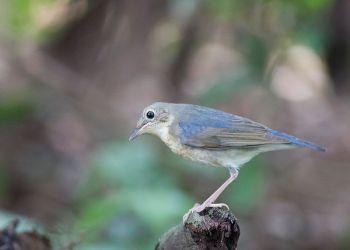- Larvivora cyane
Identification
13–14 cm (5-5½ in)
Adult males have all blue upperparts, white underparts with black-bordered throat and breast and pinkish legs.
Females have brownish upperparts, mottled/scaled throat-sides and breast with dull blue on rump and uppertail-coverts.
First-winter male resembles female with some blue on scapulars and coverts.
Distribution
Asia to Japan and Indonesia. Accidental vagrant to Alaska with 1 record.
Taxonomy
Recent research suggests that this species belongs to a new genus, uniting the East Asian Erithacus and Luscinia Robins. It's therefore placed in the genus Larvivora.
Subspecies
There are 2 subspecies[1]:
- L. c. cyane:
- L. c. bochaiensis:
Habitat
Coniferous forests with dense undergrowth near water.
Behaviour
The diet consists of insects, such as beetles, bugs and ants, as well as berries and seeds. They feed mostly on the ground.
Gallery
Click on photo for larger image
Female
Photo by Dave B
References
- Clements, J. F., T. S. Schulenberg, M. J. Iliff, S. M. Billerman, T. A. Fredericks, J. A. Gerbracht, D. Lepage, B. L. Sullivan, and C. L. Wood. 2021. The eBird/Clements checklist of Birds of the World: v2021. Downloaded from https://www.birds.cornell.edu/clementschecklist/download/
- Lepage D. (2021) [Avibase - https://avibase.ca/A8AA7E19 ]. Retrieved 5 August 2021
Recommended Citation
- BirdForum Opus contributors. (2025) Siberian Blue Robin. In: BirdForum, the forum for wild birds and birding. Retrieved 16 May 2025 from https://www.birdforum.net/opus/Siberian_Blue_Robin
External Links
GSearch checked for 2020 platform.1







